
 Size and Appearance:
Size and Appearance:
Hornets tend to be larger than yellow jackets, ranging in length from 1-1.5 inches. Their bodies feature robust structures with dark brown or black coloration accented by yellow or white markings.
Behavior and Aggressiveness:
Hornets are notorious for their aggressive nature when their nests are disturbed. Hornets will release pheromones alerting other hornets of any perceived threats, increasing the risk of multiple stings from one encounter.
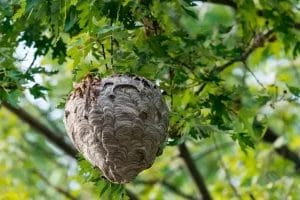 Nesting Habits:
Nesting Habits:
Hornets create paper-like nests typically found in trees, shrubs, or elevated structures with their distinctive teardrop-shaped nests often covered by protective outer layers to shield themselves from potential danger.
Hornets are found throughout North America, Europe, and Asia and typically prefer wooded areas or rural environments in which to nest; urbanized areas and densely populated places are less likely to offer suitable sites for their colonies to nest in.
Potential Dangers:
Hornet stings can be more dangerous than other insect stings because of the hornets’ aggressive behavior, which leads to more venom injection. This increases the overall risk for anyone who gets stung, especially those who may have allergic reactions or experience pain..
 Size and Appearance:
Size and Appearance:
Yellow jackets tend to be smaller than their hornet counterparts, typically measuring 0.5-0.75 inches. Their bodies tend to have more slender structures with black and yellow colorations resembling bees.
Behavior and Aggressiveness:
Yellow jackets are extremely aggressive and protective of their nests, often resorting to aggressive swarming behavior when provoked or threatened, often with multiple stings in response.
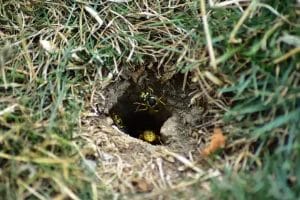 Nesting Habits:
Nesting Habits:
Yellow jackets can build their nests in different places such as underground burrows, wall voids, attics, and building eaves. These nests are typically hidden and made of papery material.
Habitats:
Yellow jackets can be found worldwide, though their population in North America is especially abundant. Their adaptability to urban environments makes them a common nuisance in residential neighborhoods, parks, and picnic grounds.
Potential Dangers:
Yellow jacket stings can also be painful and cause allergic reactions, although they typically inject less venom per sting compared to hornets. Their aggressive nature and large colony sizes make encountering them even more hazardous.
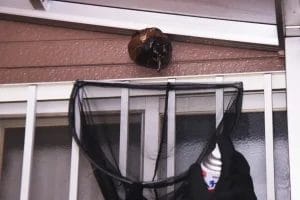
When dealing with yellow jackets and hornets, it’s essential to assess the situation and decide when it is necessary to contact a pest control company. Although these stinging insects play an integral part in the ecosystem, their nests can pose a danger if located close to human or pet living spaces. Here are some indicators of when reaching out for professional help is warranted:
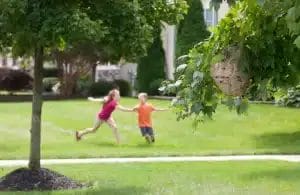 1. Nest Proximity:
1. Nest Proximity:
Yellow jackets or hornet nests located close to your home can pose an immediate danger, particularly in attics, walls, or near entrances. In such instances, professional assistance must be sought to safely remove them.
2. Aggressive Behavior:
If you witness yellow jackets or hornets behaving aggressively, such as repeated stinging or aggressive swarming, you should contact a pest control company immediately. Such aggressive behavior could indicate that their nest has been disturbed and they feel the need to defend it aggressively.
 3. Allergic Reactions:
3. Allergic Reactions:
For individuals allergic to insect stings, an encounter with yellow jackets or hornets can be life-threatening. If someone in your household experiences severe reactions from yellow jacket stings, professional assistance must be sought to eliminate their nest and minimize risks.
4. DIY attempts failed:
While there may be DIY solutions available to deal with smaller nests, if your attempts at eliminating or controlling yellow jackets or hornets have failed it’s time to seek professional pest control assistance. They have the knowledge, tools, and experience needed to effectively eliminate infestations.
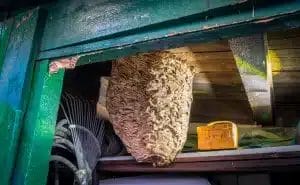 5. Large nests:
5. Large nests:
If the nest has become large enough, it is wise to consult professionals as removal may prove challenging and hazardous without adequate equipment and experience. Larger nests can house hundreds of stinging insects which makes removal more complex and hazardous without proper training and knowledge.
Yellow jackets and hornets can become aggressive if their nests are threatened, so professional pest control services provide safe removal of their nest, minimizing risks of stings to you and your family. When dealing with yellow jackets or hornets, make safety a top priority and seek assistance from pest management companies for optimal removal solutions.
Knowing the difference between hornets and yellow jackets can be a matter of safety for yourself and those around you. After all, if you’re dealing with hornets, it might be wise to call a pest control specialist to get rid of them as they can become quite dangerous when provoked. No matter which type of wasps you find in your area, it’s important to understand the characteristics of both varieties to ensure that you can keep yourself safe in any situation. It’s also a good idea to take the opportunity to educate others on these differences so that everyone can remain aware of what kind of wasps they may come across during their daily activities. That way, everyone will know exactly how to handle an encounter with either hornets or yellow jackets should they arise.
